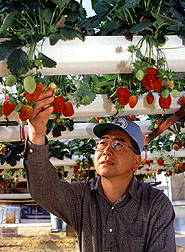Hydroponic Strawberries Avoid Soil Pests
|
|
The first recorded use of hydroponics is in one of the seven wonders of the ancient world: the Hanging Gardens of Babylon where, historians say, plants were grown in a steady stream of water. Centuries later, U.S. troops stationed on infertile Pacific Islands during World War II ate fresh fruits and vegetables produced by hydroponics.
Hydroponics from the Greek words hydro (water) and ponos (labor) is the science of growing plants without soil. Nutrients that plants usually get from soil are added to water.
Scientists with USDA's Agricultural Research Service successfully using this time-honored way of producing crops at the Appalachian Fruit Research Station in Kearneysville, West Virginia.
There, they are using hydroponics to grow strawberries without soil and even more, without pesticides.
But why hydroponics?
"Strawberry growers worldwide fumigate the soil with methyl bromide before planting to control soilborne insect pests, diseases, and weeds," says Fumiomi Takeda, an ARS horticulturist at Kearneysville. "This fumigation is essential to get high yields and high-qualify fruit.
"But with the fast-approaching ban on use of this chemical, growers are anxiously looking for alternatives. It is estimated that banning methyl bromide will cut in half the annual production of field-grown strawberries in California and Florida, our major producing states."
But growing strawberries hydroponically eliminates the need for methyl bromide on this crop.
As for foliage pests, Takeda says, "Two-spotted spider mites, thrips, and powdery mildew were the major problems we encountered in our greenhouse production of strawberries. We used beneficial predatory mites to control the thrips and two-spotted mites. The mildew problem can be resolved by moderating the humidity level in the greenhouse and by growing varieties that resist mildew infection," he says.
In the Kearneysville greenhouse, Takeda grew strawberries in round pots, vertically stacked square pots, and horizontal troughs similar to rain gutters. [See "Trading Wastewater for Crops," Agricultural Research, February 1995, pp. 10-11.]
He used both established plants and runner tips from greenhouse-grown Chandler and Camarosa, strawberry varieties developed in California; Sweet Charlie, developed in Florida; and Tribute and Primetime, developed by ARS in Beltsville, Maryland. He also included freshly dug Canadian nursery plants of Chandler, Camarosa, and Sweet Charlie.
"We controlled temperatures at 68oF during the day and 57oF at night, and we preconditioned transplants for 150 degree-hours of chilling at or below 45oF. Combining this with the natural photoperiod and supplemental lights during overcast days produced plants that yielded lots of good-sized fruit," Takeda says.
Camarosa proved to be the most productive variety. "We picked over 2 pounds of marketable strawberries from each Camarosa plant," Takeda reports. In soil fumigated with methyl bromide, Camarosa and Chandler will each yield over 2 pounds of high-quality fruit.
In late August 1997, Takeda set runner tips in bedding plant containers with peat mixture to produce "plug" plants. He misted the plants intermittently until they had well-developed roots. On October 1, plug plants and fresh-dug plants shipped from Canada were placed in the hydroponic growing systems.
Takeda subjected plants in troughs to a continuous flow of recirculating nutrient solution. He fed the plants in pots intermittently with a nutrient solution and also transplanted plug plants to pots stacked to form towers.
"We harvested ripe fruit twice a week from December to May, the period when shipments of California strawberries slow down. Fruit quality and taste were excellent," he says.
Transplants or plug plants produced more fruit than field-nursery plants. According to Takeda, the root system of both types of plants remained healthy throughout the 7- to 8-month growing period, with no appearance of root diseases. However, in the stacked-pot towers, the top sections got more light and therefore bore healthier plants and more fruit.
Light intensity greatly affects strawberry growth and development. Since light levels reaching the plants at the lower section of the towers were only 20 percent of levels measured at the top, fruit production was reduced.
"Slightly taller pots spaced farther apart on the towers would reduce this problem," says Takeda.
Bruce Pape, an organic grower of herbs and ornamentals on Maryland's Eastern Shore, has been experimenting with pot-grown strawberries as ornamental plants. "We have some specialty market outlets that would probably be able to sell ornamental strawberry plants quite well," he says. "Consumers would not only get a beautiful ornamental hanging basket, but a way to grow a few strawberries in the winter months as well." Pape and his wife Carmen have experimented with several strawberry varieties.
Hydroponic systems reduce space requirements and growing time needed to produce a crop. Since there is no soil involved, no tillage is necessary and there are no weeds to contend with. The amount of chemicals needed is reduced, since biocontrol measures work better in the controlled environment of a greenhouse and there are fewer pests.
Environmental factors aren't a problem in greenhouses since lighting, temperature, humidity, and irrigation can be controlled. Nutrients used for plant growth are recyclable, to be used again and again.
Using hydroponics also reduces the cost and increases the efficiency of labor. Field-harvesting strawberries involves back-breaking labor, since laborers must stoop to pick the crop. Hydroponically grown berries can be harvested from a standing position.
"Although initial set-up costs for hydroponic farming are high, growers may recoup that cost by producing a higher value product, increasing yields, and spending less money to control pests and diseases," says Takeda. "Our research demonstrated that two California strawberry varieties can be grown by soilless means. However, we need more research to measure the performance of other strawberry varieties and to investigate the influence of plant type--plug, fresh-dug, dormant, or single or multiple crown as well as planting dates."--By Doris Stanley, Agricultural Research Service Information Staff.
Fumiomi Takeda is at the USDA-ARS Appalachian Fruit Research Station, 45 Wiltshire Rd., Kearneysville, WV 25430-9425; phone (304) 725-3451, ext. 212, fax (304) 728-2340.
"Hydroponic Strawberries Avoid Soil Pests" was published in the November 1998 issue of Agricultural Research magazine. Click here to see this issue's table of contents.







